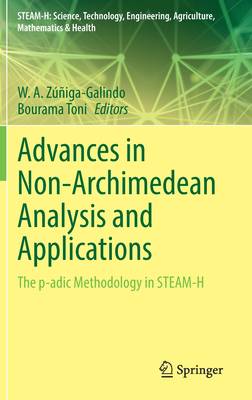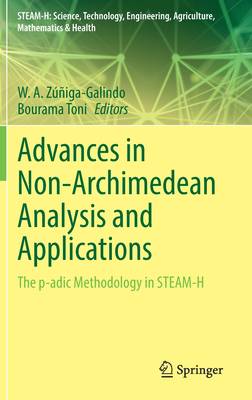
- Retrait gratuit dans votre magasin Club
- 7.000.000 titres dans notre catalogue
- Payer en toute sécurité
- Toujours un magasin près de chez vous
- Retrait gratuit dans votre magasin Club
- 7.000.0000 titres dans notre catalogue
- Payer en toute sécurité
- Toujours un magasin près de chez vous
Advances in Non-Archimedean Analysis and Applications
The P-Adic Methodology in Steam-H
126,95 €
+ 253 points
Description
This book provides a broad, interdisciplinary overview of non-Archimedean analysis and its applications. Featuring new techniques developed by leading experts in the field, it highlights the relevance and depth of this important area of mathematics, in particular its expanding reach into the physical, biological, social, and computational sciences as well as engineering and technology.
In the last forty years the connections between non-Archimedean mathematics and disciplines such as physics, biology, economics and engineering, have received considerable attention. Ultrametric spaces appear naturally in models where hierarchy plays a central role - a phenomenon known as ultrametricity. In the 80s, the idea of using ultrametric spaces to describe the states of complex systems, with a natural hierarchical structure, emerged in the works of Fraunfelder, Parisi, Stein and others. A central paradigm in the physics of certain complex systems - for instance, proteins - asserts that the dynamics of such a system can be modeled as a random walk on the energy landscape of the system. To construct mathematical models, the energy landscape is approximated by an ultrametric space (a finite rooted tree), and then the dynamics of the system is modeled as a random walk on the leaves of a finite tree. In the same decade, Volovich proposed using ultrametric spaces in physical models dealing with very short distances. This conjecture has led to a large body of research in quantum field theory and string theory. In economics, the non-Archimedean utility theory uses probability measures with values in ordered non-Archimedean fields. Ultrametric spaces are also vital in classification and clustering techniques. Currently, researchers are actively investigating the following areas: p-adic dynamical systems, p-adic techniques in cryptography, p-adic reaction-diffusion equations and biological models, p-adic models in geophysics, stochastic processes in ultrametric spaces, applications of ultrametric spaces in data processing, and more. This contributed volume gathers the latest theoretical developments as well as state-of-the art applications of non-Archimedean analysis. It covers non-Archimedean and non-commutative geometry, renormalization, p-adic quantum field theory and p-adic quantum mechanics, as well as p-adic string theory and p-adic dynamics. Further topics include ultrametric bioinformation, cryptography and bioinformatics in p-adic settings, non-Archimedean spacetime, gravity and cosmology, p-adic methods in spin glasses, and non-Archimedean analysis of mental spaces. By doing so, it highlights new avenues of research in the mathematical sciences, biosciences and computational sciences.
In the last forty years the connections between non-Archimedean mathematics and disciplines such as physics, biology, economics and engineering, have received considerable attention. Ultrametric spaces appear naturally in models where hierarchy plays a central role - a phenomenon known as ultrametricity. In the 80s, the idea of using ultrametric spaces to describe the states of complex systems, with a natural hierarchical structure, emerged in the works of Fraunfelder, Parisi, Stein and others. A central paradigm in the physics of certain complex systems - for instance, proteins - asserts that the dynamics of such a system can be modeled as a random walk on the energy landscape of the system. To construct mathematical models, the energy landscape is approximated by an ultrametric space (a finite rooted tree), and then the dynamics of the system is modeled as a random walk on the leaves of a finite tree. In the same decade, Volovich proposed using ultrametric spaces in physical models dealing with very short distances. This conjecture has led to a large body of research in quantum field theory and string theory. In economics, the non-Archimedean utility theory uses probability measures with values in ordered non-Archimedean fields. Ultrametric spaces are also vital in classification and clustering techniques. Currently, researchers are actively investigating the following areas: p-adic dynamical systems, p-adic techniques in cryptography, p-adic reaction-diffusion equations and biological models, p-adic models in geophysics, stochastic processes in ultrametric spaces, applications of ultrametric spaces in data processing, and more. This contributed volume gathers the latest theoretical developments as well as state-of-the art applications of non-Archimedean analysis. It covers non-Archimedean and non-commutative geometry, renormalization, p-adic quantum field theory and p-adic quantum mechanics, as well as p-adic string theory and p-adic dynamics. Further topics include ultrametric bioinformation, cryptography and bioinformatics in p-adic settings, non-Archimedean spacetime, gravity and cosmology, p-adic methods in spin glasses, and non-Archimedean analysis of mental spaces. By doing so, it highlights new avenues of research in the mathematical sciences, biosciences and computational sciences.
Spécifications
Parties prenantes
- Editeur:
Contenu
- Nombre de pages :
- 318
- Langue:
- Anglais
- Collection :
Caractéristiques
- EAN:
- 9783030819750
- Date de parution :
- 02-12-21
- Format:
- Livre relié
- Format numérique:
- Genaaid
- Dimensions :
- 156 mm x 234 mm
- Poids :
- 644 g

Les avis
Nous publions uniquement les avis qui respectent les conditions requises. Consultez nos conditions pour les avis.





